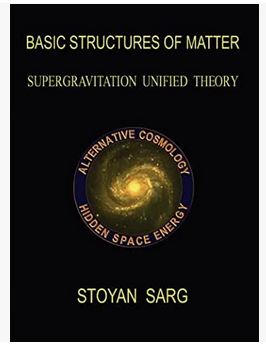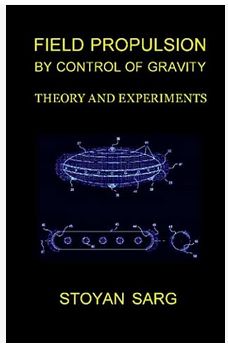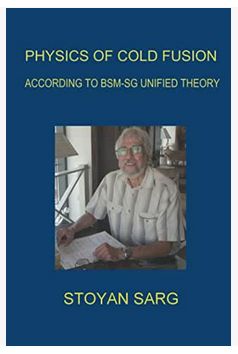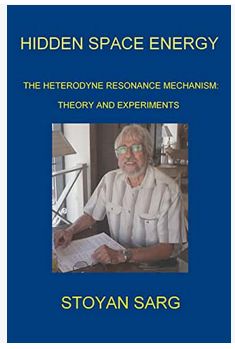





EARTH CIVILIZATION AND UNIVERSE SOCIETY MANIFESTO
MEMORANDUM: SAVE OUR CIVILIZATION FROM SELF-DESTRUCTION (LOSS OF THE ATMOSPHERE) WEB TEXT or PDF





Links to publications of Dr. Stoyan Sarg related to the BSM-SG Unified Theory
Stoyan Sarg Sargoytchev, Graphycal 3D Modeling of Molecules and Nanostructures in Sub-Nanometric Scale with the BSM-SG Atomic Models. (Plenary talk at 3rd International Conference Nanotek & Expo, 2-4 Dec 2013, Las Vegas, USA; slides in slideshare.net: Search Stoyan Sarg)
First and second motion experiments confirming the predicted gravito-inertial effect
Author: Stoyan Sarg; Book: "BASIC STRUCTURES OF MATTER - SUPERGRAVITATION UNIFIED THEORY, Trafford Publishing, Book info and extracts; Book presentations; info by publisher and direct purchasing or by Amazon.com (search by title)
Author: Stoyan Sarg; Book "BEYOND THE VISIBLE UNIVERSE" (2004) (popular presentation) (more info and purchasing)
Article in a peer reviewed journal devoted on fundamental questions in Physics: S. Sarg, A Physical Model of the Electron According to the Basic Structures of Matter Hypothesis, Physics Essays, v. 16, No. 2, 180-195, (2003) ( cited in Scopus database: www.info.scopus.com )
Books review in "Physics in Canada,", v. 62, No. 4, July/Aug, 2006, published by the Canadian Association of Physicists
Reports in IX International Scientific Conference " Matter, Space, Gravitation, 7-11 Aug 2006, St. Petersburg, Russia
Book presentation and poster report in the International Conference on Future Energy (COFE-2006) 22-24 Sep 2006, Washington DC.
Table of modern Ether drift experiments (in peer reviewed journals) confirming the existence of an absolute reference frame in space (in contradiction to the postulate of Relativity)
Presently, the existing crisis in Cosmology is almost acknowledged by the main stream science. The origin of all problems in Physics, including the Cosmology comes from the adopted concept of the physical vacuum, which is incorrect, so it led to adoption of some wrong postulates. This is a fundamental problem affecting different fields of Physics. In Particle Physics it led to wrong concept about microcosmos. In Cosmology it led to a wrong picture about the Universe
See: 1st Crisis in Cosmology Conference (CCC-I), June 23-25, 2005 www.cosmology.info/2005conference
In 1920 Albert Einstein came to a fateful conclusion about the existence of Ether - a fact of extreme importance missing in the contemporary Physics textbooks (a documentary movie and excerpts from original Einstein's book)
The "dark matter" is not in distant galaxies! We live in a sea of hidden matter - around us and within us - a underlying structure of the physical vacuum! It can serve as a reference point for solving the space-time enigma! RESULTS: Physics with objective reality, causality and logical understanding! Unified theory without absurdness! A new vision about Micro-world and Universe! Particle physics without infinities, Quantum Mechanics without uncertainty principle, Relativity without paradoxes, Cosmology beyond the controversial "Big Bag"! Structure of elementary particles and physical models of the atoms! What is behind "annihilation"? Classical approach leading to understanding how the electrical and magnetic fields are related to the gravity.
(The physical vacuum should not be confused with the technical vacuum!)
AMAZING TREASURES IN THE THEORETICAL AND APPLIED FIELDS OF PHYSICS STAY UNTOUCHED!
The
treatise BASIC STRUCTURES OF MATTER � SUPERGRAVITATION UNIFIED THEORY (BSM-SG)
is based on an original idea about physical vacuum, which has never been
investigated before. It follows the recommendation of James Clerk Maxwell
expressed in his "A Treatise on Electricity and Magnetism" vol. II,
section "A medium necessary":
In
fact, whenever energy is transmitted from one body to another in time, there
must be a medium or substance in which the energy exist after it leaves one body
and before it reaches the other... Hence,
all these theories lead to the conception of a medium in which the propagation
takes place
The BSM-SG theory unveils the relation between the forces in Nature by
adopting the following framework:
- Empty Euclidian space without any physical properties and restrictions
- Two super dens fundamental particles able to vibrate and congregate.
Their parameters are associated with the Planck�s scale.
- A Fundamental law of Super Gravitation (SG) - an inverse cubic law
valid in pure empty space.
An enormous abundance of these two particles, with energy beyond some
critical level, are able to congregate into self-organized hierarchical levels
of geometrical formations, based on the fundamental SG law. This leads
deterministically to creation of space with quantum properties (known as
physical vacuum) and a galaxy as observable matter. All known laws of Physics
are embedded in the underlying structure of the physical vacuum and the
structure of the elementary particles. The fundamental SG law is behind the
gravitational, electric and magnetic fields and governs all kinds of
interactions between the elementary particles in the space of physical vacuum.
The revealed structures of the physical vacuum and elementary particles with interactions governed by SG law permit analysis of longstanding problems in different fields of Physics (Particle Physics, Quantum mechanics, Relativity and Cosmology) by using a classical approach in a real 3-D Euclidian space. The gravity and the electrical charge are not intrinsic features of the particles, but effects of interaction between particle's structure and the fine structure of the physical vacuum. The magnetism and inertia are specific reaction effects of the physical vacuum in a case of particle motion. The applied original approach permits a deeper insight into lower levels of matter organization, levels below the elementary particles. Any physical phenomenon or unsolved problem could be effectively analyzed at such levels. Every point of space in which we live and observe (down to ~ 1X10-20 m) contains two types of Zero Point Energy (ZPE) - a static and a dynamic one. Presently, the dynamic one is only envisioned by contemporary physics. The observable signature of the dynamic ZPE is the Microwave Cosmic Background temperature of 2.72K. (see the derived results in Chapter 5 of BSM). The hidden static ZPE is much larger and it is a source of the nuclear energy.
| Objectives and Policy of HSF | Great Thoughts about Physics | Fundamental problems in physics | New approach | Highlights of BSM theory | Helium nucleus and Hydrogen atom (movies) | Synthetic images of some atomic nuclei | Applications (New Vision About Fusion Energy; Theoretical analysis of bio-molecules using BSM atomic models (energy properties of proteins)| Modeling in nanotechnology
| Helical structures of electron, proton and neutron | Equations derived by BSM theory | PERIODIC TABLE OF ATOMIC NUCLEAR STRUCTURES with clickable cells | Similarity between some Kabala patterns and atoms
Educational Website about the atomic structures (illustrated)
|Download info for BSM theory and Atlas of Atomic Nuclear Structures | Program of HSF |
| Updated Messages |
(a new vision about the Universe and the evolution of the galaxies)
The Helical Structures Forum (HSF) is an international club with purpose for discussion and promotion of advanced scientific knowledge about the physical structures in the nature from micro to macro scale. HSF endorses a new approach for study of natural phenomena in different fields of physics. The principles of real objectivity, causality and logical understanding are strongly observed. The analysis must be free of absurdness, logical inconsistency and abstractness. (See more about the objectives of HSF). The new approach and methodology are described in the article http://lanl.arxiv.org/abs/physics/0205052 (May, 2002). They are applied in the recently physical theory called Basic Structures of Matter - Supergravitational unified theory (BSM-SG). BSM-SG puts the theoretical physics in the direction envisioned by the greatest physicists, Isaac Newton, Michael Faraday, James Maxwell, Nikola Tesla, lord Kelvin, Albert Einstein BSM restores the wrong turn in the Theoretical Physics made in the past century.
The discussion club of HSF is the Yahoo group "matter-energy-gravitation" (see the bottom of this page).
While free of unnecessary abstractness, BSM-SG theory permits a new approach for interdisciplinary studies.
Challenging the traditional way of studying some enigmatic problems in Physics (relations between gravity, electricity, magnetism and inertia; zero point energy, space-time enigma; quantum mechanics, relativistic phenomena and the relation between them)
Atomic physics with a visual perception. Visualizing the unseen world of the elementary particles with their rich structures by real 3D views.
Bridging the gap between fundamental physical science and applied fields. FIELDS OF APPLICATION: Using the derived atomic models and revealed subatomic processes permits a deeper insight into: New energy, Analysis of biomolecules, Modeling in nanotechnology.
The successful analysis of tough physical problems when applying the BSM theory can be compared to the fast advance of the computer science. Reason: They both rely on clearly defined fundamental concepts, while the following developments comply to the logical principles.
New horizon for different fields ! (structural chemistry, nanotechnology, molecular biology, DNA and cancer research)
Stoyan Sarg
ISBN 0-9730515-0-7; AMICUS No. 27105955
(I devote this thesis to the memory of Nikola Tesla - the first researcher of the transient properties of space)
"Understanding the properties of air and water, the man moves through such media. He will move through the space, when understanding the structure and properties of the physical vacuum" (S.Sarg)
Abstract. The thesis Basic Structures of Matter - Supergravitation Unified Theory (BSM-SG) applies a theoretical approach in which a more general concept about matter, space, time and gravitation is used. The known physical laws and postulates are derivable if considering that the physical vacuum is a classical void space filled with a unique self-sustainable grid. A model called Cosmic Lattice (CL) is suggested according to which the vacuum possesses an underlying structure built of two types of super dens and small sub-elementary particles arranged in 3D lattice nodes. These particles, denoted as twisted prisms, are natural geometrical formations of two super-dense fundamental particles associated with the Planck's scale. In a pure void space the prisms of the same type are attracted by forces inversely proportional to the cube of the distance. These forces are attributes of Super Gravitational (SG) field, a fundamental law in Nature governing the interactions between such of super-dense particles, which build also the elementary particles. Additionally, the SG field of the prisms exhibit an axial anisotropy and a right or left hand twisting due their lower level structure. The observable space is filled by CL grid of alternatively arranged nodes in a diamond type of lattice. Each node contains 4 prisms of same type kept by SG forces. The estimated node distance is about (1~2)*10-20 m, while the intrinsic matter density of the prisms is about 1013 times greater than the average density of atomic matter. The individual node of the CL structure has a flexible geometry, a freedom to oscillate in a complex spatial mode, so it possesses an energy well. The complex dynamics of CL node oscillations is related to the physical parameters permeability and permittivity of free space. The common mode oscillations with running phase synchronization are related to the parameters Compton wavelength and velocity of light. The CL space exhibits quantum features and provides conditions for fields: gravitational, electrical and magnetic. The latter two fields get physical explanations in which specific parameters of the CL node dynamics are involved. The elementary particles (involved in the proton and neutron) are complex helical structures built of prisms in a unique process of crystallization. The lower order helical structure has a right or left-hand twisted internal lattice which is denser than the Cosmic Lattice. The SG field of this internal lattice is able to modulate in a specific way some of the oscillating parameters of the surrounding CL nodes, creating in such way an electrical field. The same internal lattice causes a displacement and folding of the CL nodes when the particle moves in CL space. This process in which proximity fields are involved defines the intrinsic inertial properties of the elementary particles and atomic matter. Some of the most specific CL space parameters are the following: a Static CL pressure, a Dynamical CL pressure and a Partial CL pressure. They are related respectively to: the mass of the elementary particles, the CL space background temperature (2.72K), and the inertia of the atomic matter. Theoretical equations of these parameters are found and expressed by the known physical constants. A mass equation applicable for the elementary particles is derived by analysis of the dynamical interactions of the electron in CL space environment. The Planck�s constant and the Quantum mechanical rules obtain physical explanations. The velocity of light is a derivable parameter. The relativistic concept of an inertial frame obtains a logical physical explanation and the effects of the General and Special relativity are understandable. The CL space allows also propagation of charge quantum waves - virtual particles, which sometimes could be confused with the real ones. The results from the developed models are in excellent agreement with all experimental and observational data in a range from the micro-cosmos to Cosmology.
From the point of view of the developed concept, the adopted validity of some of the physical laws and postulates is not absolute. This put the existed so far vision about the micro and macro Cosmos into question, while permitting a deeper insight into the fundamental physical processes in Nature. BSM-SG brings unperturbed logical understanding of every physical phenomenon.
The proposed BSM-SG models are verified by cross validation of their output results with experimental data from different fields of physics. The unveiled low level material structures, involved in the physical vacuum and the elementary particles, further allows deciphering the structures of of the atomic nuclei. It appears that the rows and column pattern of the Periodic table is a signature of the protons and neutrons spatial arrangement in the nuclei. The electronic orbitals are strictly defined by the atomic nuclear configuration. In this aspect, one of the most useful results from the BSM-SG theory is an illustrative appendix titled Atlas of Atomic Nuclear Structures (ANS) showing the structural arrangement of the protons and neutrons in the atomic nuclei for elements from Hydrogen to Lawrencium (Z = 103). The individual protons and neutrons are presented by symbols, in order to simplify the complex nuclear drawings. The electronic orbitals are not shown in the nuclear views, but their spatial positions are easily identifiable.
The Atlas of Atomic Nuclear Structures (ISBN 0-9730515-1-5) contains: Part I - Helical structures of subatomic and atomic particles; Part II - The atomic nuclear structures for the elements in the range of 1< Z < 103; Periodic table poster and theoretically obtained views of some atomic nuclei.
The article "Brief introduction to BSM theory and derived atomic models", published initially in Journal of Theoretics, is useful for initial introduction to the original concept. A complete summary about the BSM theory and derived output results is provided by the "Abstract paper of BSM theory". (See the hyperlinks below).
The article "A physical model of the electron according to the Basic Structures of Matter hypothesis" is the first publication of one selected result in established peer reviewed journal "Physics Essays" (V. 16 No 2, 180-195, (2003)),an international journal dedicated to fundamental questions in Physics. It is cited in Scopus (the world largest abstract and citation database).
Publication about the REVEALED STRUCTURE OF THE ELECTRON in Physics Essays (International Journal dedicated to Fundamental Questions in Physics)
Atlas of Atomic Nuclear Structures viXra:1107.0031 submitted on 16 Jul 2011, (1447 unique-IP downloads)(including the structure of elementary particles), (firstly published in Journal of Theoretics, 2002, but presently on-line section is not available)
The largest and smallest lengths and frequencies in Universe
Abstract paper of BSM (submitted to arxiv.org in 2002 but not published after first rejection from moderator)
The newly discovered fundamental relation between super-massive black holes and their host galaxies supports the hypothesis for galaxy formation provided by BSM see more
The first (2001) and second (2005) editions of the BSM theory are electronic and contains 12 chapters. The third revised edition (2006) is a book with additional chapter 13. The mathematical analysis is accompanied by rich graphical illustrations including hundreds of figures. The results of the developed models are compared with experimental and observational data. Only data from peer-reviewed sources are used. Some of these data are included as figures with citation of their sources.
Some advices to the reader. The BSM-SG unified theory is based on more general considerations about matter, space and time. The new approach involves reformulation of some of the fundamental physical laws, while the known laws and postulates become derivable or apparent from the analysis. At the beginning of the treatise, a number of new parameters and structures had to be introduced, while avoiding any abstractive assumptions. For this reason the reader is advised to follow the consecutive order of the chapters. Due to the fundamental aspect of the BSM-SG concept, the presented analysis touches different fields of physics. Some features of the fundamental relations between matter, energy, and gravitation become apparent after a detailed acquaintance with the treatise. Once the reader become familiar with the BSM-SG concept, the predicted applications appear logically understandable.
Downloading info and recommendations:
(a) BSM-SG theory
Electronic publication: The electronic publications of the first and second editions of the treatise has been free downloadable from 2001 to 2006, until publishing the book by Trafford Publishing, Canada. After that only some book excerpts are temporally downloadable. The Atlas of ANS is still available for download.
BSM-SG theory excerpts (temporally available)
(b) Atlas of ANS
Atlas of Atomic Nuclear Structures downloading table (from this website)
List of corrections and updates List of errors
1. The first and second electronic versions of the BSM treatise and the Atlas of Atomic Nuclear Structures are archived permanently in Electronic collections of the National Library of Canada: www.nlc-bnc.ca/amicus/index-e.html
2. The BSM thesis and the Atlas of ANS are both copyright protected. The author gives a temporal authorization for free distribution of the electronic version of the Atlas of ANS.
Interested of New Millennium Physics and new discoveries? - put a link to this website!

Note: Messages without text or containing attachments are filtered out.
Useful links related to the search of the Truth for understanding the reality:
www.cosmology.info/2005conference 1st Crisis in Cosmology Conference (CCC-1), June 23-25, 2005
http://www.orgonelab.org/miller.htm Dayton Miller (1866-1941) - provides the first experimental proof for the existence of Ether by detection of the annual Earth motion velocity through space
http://pacenet.homestead.com Planetary Association for Clean Energy
www.einsteinconspiracy.co.uk About a distorted interpretation of the original views of some great physicists in the past
This website owner is the Helical Structures Press, Canada with the purpose of scientific research challenging some adopted concepts in physics that are obstacle for deeper understanding of Nature. The long range goals of the Helical Structures Press are contemplated to vital problems of the humanity: solving the energy problem, preserving the ecology and the natural environments on the Earth.
Created: 17 Nov 2001
Last update: 2 Feb 2023
Copyright � 2001 HSF! All rights reserved.